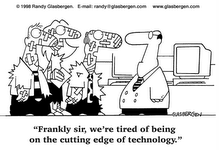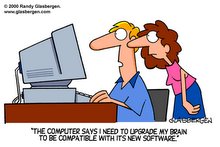I am back from a wonderful vacation to the Black Hills! Anyway, I thought I would share this information concerning software piracy.
From IDC
Worldwide Software Piracy Rate Holds Steady at 35%, Global Losses Up 15%
15 May 2007
Piracy Rate in China Drops 10% in Three Years
WASHINGTON, D.C., May 15, 2007 — A new study reveals that 35% of the software installed in 2006 on personal computers (PCs) worldwide was obtained illegally, amounting to nearly $40 billion in global losses due to software piracy. Progress was seen in a number of emerging markets, most notably in China, where the piracy rate dropped ten percentage points in three years, and in Russia, where piracy fell seven percentage points over three years.
These are among the findings of the fourth annual global PC software piracy study released today by the Business Software Alliance (BSA), an international association representing the commercial software industry. The study was conducted independently by IDC, the information technology (IT) industry's leading global market research and forecasting firm.
"The good news is we are making progress, however, we still have a lot of work to do to reduce unacceptable levels of piracy," said BSA President and CEO Robert Holleyman. "These significant losses translate into negative impacts on IT industry employment, revenues, and financial resources available for future innovation and the development of new technologies."
Worldwide, for every two dollars of software purchased legitimately, one dollar was obtained illegally. Global losses increased in 2006 by more than $5 billion (15%) over the previous year. Of the 102 countries covered in this year's study, piracy rates dropped moderately in sixty-two countries, while increasing in thirteen.
China's piracy rate dropped four percentage points for the second consecutive year and has dropped ten percentage points in the last three years, from 92% in 2003 to 82% in 2006. By reducing China's piracy rate by ten percentage points over three years, $864 million in losses was saved, according to IDC. The reduction in the piracy rate and the savings are the result of government efforts to increase the use of legitimate software within its own departments, vendor arrangements with PC suppliers to use legitimate software, and increasing industry and government education and enforcement efforts. The legitimate software market in China grew to nearly $1.2 billion in 2006, an increase of 88% over 2005. Since 2003, the legitimate software market in China has grown over 358%.
"Considering the vast PC growth taking place in the Chinese IT market, this continued decline in China's software piracy rate is quite promising," said Holleyman. "BSA is encouraged by the commitment from the Chinese government to ensure legal software use. We look forward to continued dialogue between the US and China aimed at addressing issues that affect both economies."
And in Russia, the piracy rate decreased by seven percentage points since 2003, down from 87% in 2003 to 80% in 2006.
In addition, the study indicates that even relatively low piracy rates can amount to huge losses in large markets. For example, while the U.S. had the lowest piracy rate of all countries studied at 21%, it also had the greatest total losses at $7.3 billion. China saw the second highest losses at $5.4 billion with a piracy rate of 82%, followed by France with losses of $2.7 billion and a piracy rate of 45%.
Other key findings:
In more than half of the 102 countries studied, the piracy rate exceeded 60%. In approximately one third of the countries, the piracy rate exceeded 75%.
Emerging markets in Asia/Pacific, Latin America, Eastern Europe, and the Middle East and Africa accounted for one-third of PC shipments, but only 10% of spending on PC software.
The European Union (EU) and Canada continue to have high losses despite low piracy rates. The EU had losses of $11 billion with a 36% piracy rate, while Canada had losses of $784 million with a 34% piracy rate.
Over the next four years, businesses and consumers worldwide will spend $350 billion on PC software. If current trends continue, the study predicts more than $180 billion worth of PC software will be pirated during that period.
"A number of factors contribute to regional differences in piracy: the strength of intellectual property protection, the availability of pirated software, and cultural differences," said John Gantz, chief research officer at IDC. "Reducing software piracy around the world will take much more work and investment, but those efforts will pay off in the form of stronger local IT industries that drive broader economic growth."
"The critical elements of the global fight against software piracy are education, strong government policy, and enforcement," said Holleyman. "Expanded access to the Internet in emerging markets is making piracy more convenient, which makes it all the more imperative to keep up anti-piracy efforts."
Tuesday, May 29, 2007
Saturday, May 5, 2007
I saw my first Mac!
Well, after having worked in IT for some 25 years, I finally broke down and went to see what a Macintosh computer looked like. What I like about it is that it runs on top of a variant of a Unix-based OS. What I don't like about it is its UI. I know that is one of the selling features of the Mac. I just didn't care for how on its current OS version all of the icons are on the bottom and if you cursor over them they expand in size and kind of pop out at you. Personally, I just find this disorienting. Just like I also detest flashing HTML. What I like about it is that hackers write viruses for Windows since Mac is only about 5.8 percent of the personal computer market. Many people don't have load anti-virus software on their Mac. This is from a report from Macworld, "According to IDC’s report, the growth puts Apple’s market share at 5.8 percent (fourth place overall), ahead of Toshiba at 4.2 percent. Dell topped the U.S. market with 31 percent, but suffered a negative growth rate of -6.7 percent. The top 5 is rounded out by HP with a 22 percent share and Gateway with a 6 percent share." HP is currently the dominant pc maker. I am writing on a HP right now.
a SOA class at IBM
I attended a free 3-day class (free for IBM partners) titled “Designing SOA Solutions with the IBM Foundation” from April 30 to May 2, 2007. I found the class very useful. Although the class somewhat deviated from the planned agenda, I found the dialog quite intriguing. All of the participants had SOA experience and knowledge and came with plenty of questions and offered valuable feedback and real life experiences. Incidentally, out of 10 people, I was the only female (typical) and only one of two Americans. The other American was also from my company. I was able to get a quick glance at some of the framework provided within IBM’s rather closely guarded and propreitary closed Service-Oriented Modeling and Architecture (SOMA) methodology. SOMA is IBM’s approach to service modeling, service design and service deployment. SOMA covers a broad scope and implements service-oriented analysis and design (SOAD) through the identification, specification and realization of services, components that realize those services (a.k.a. "service components"), and the flows that can be used to compose services. A description of SOMA is available in the article "Service-oriented Modeling and Architecture: How to Identify, Specify and Realize Services". SOMA includes an analysis and design method that extends traditional object-oriented and component-based analysis and design methods to include concerns relevant to and supporting SOA. IBM has integrated SOMA with its RUP methodology and its tools, particularly the Websphere line of products.
Subscribe to:
Posts (Atom)


